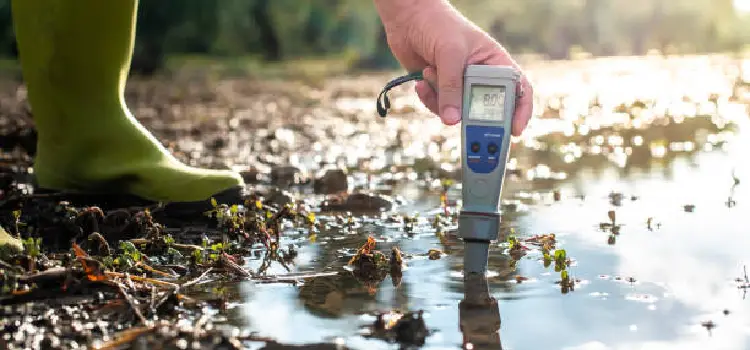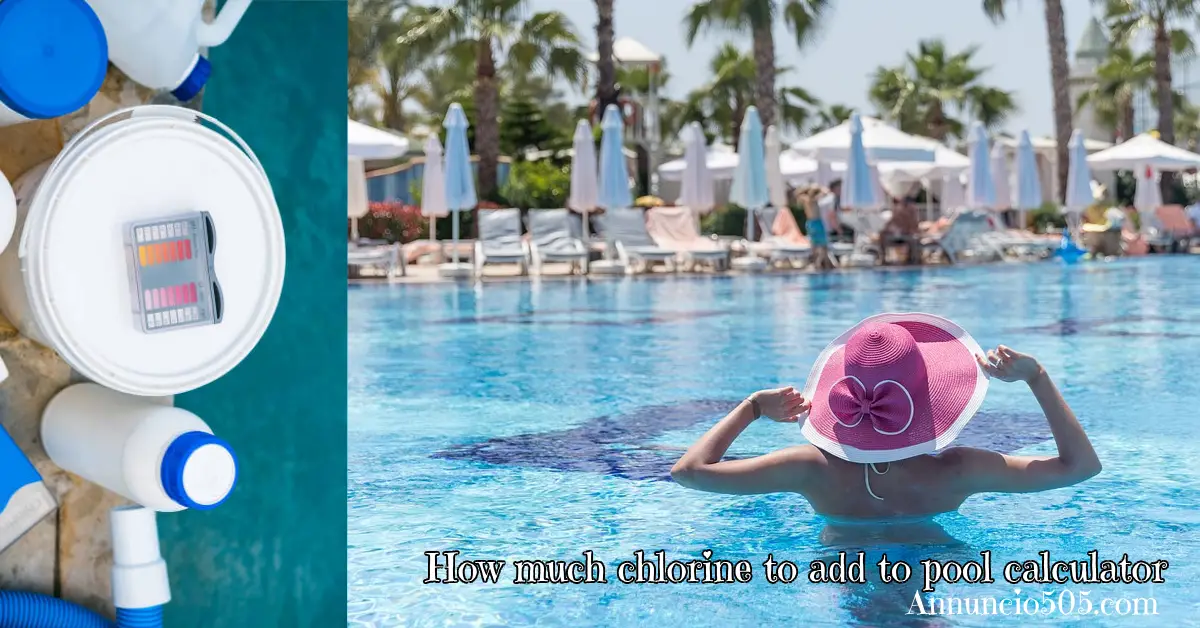Owning a pool comes with the joy of relaxation and fun, but it also requires proper maintenance to ensure the water remains clean and safe for swimming. One of the key elements of pool maintenance is keeping chlorine levels balanced. Too much or too little chlorine can have a significant impact on the water quality, and finding the right amount to add can be tricky. That’s where a “how much chlorine to add to pool calculator” becomes your best friend. Lets know about Chlorine to Add to Pool Calculator.
In this guide, we’ll walk you through the process of using a chlorine calculator, the factors that influence chlorine levels, and how to maintain your pool like a pro. Whether you’re new to pool care or a seasoned pool owner, this article will provide you with actionable insights to keep your water sparkling clean.
Table of Contents
ToggleWhy Chlorine is Essential for Your Pool
Chlorine is a chemical element that plays a vital role in disinfecting pool water. It kills harmful bacteria, viruses, and algae that can thrive in standing water. Chlorine to Add to Pool Calculator and Proper chlorine levels not only keep the water clean but also ensure the safety of swimmers by preventing the spread of waterborne illnesses.
If you don’t maintain the right chlorine levels, the water can become cloudy, develop a bad odor, and even cause skin irritation. Hence, understanding how much chlorine to add to your pool is crucial for its upkeep. The pool calculator can help you to understand.
Understanding Chlorine Levels in Your Pool
Before diving into how much chlorine to add, it’s essential to understand how chlorine levels are measured. Chlorine in pool water is measured in parts per million (ppm), with the ideal level typically falling between 1.0 and 3.0 ppm for a standard residential pool.
Factors like weather conditions, pool usage, and water temperature can all influence chlorine demand. For example, a hot, sunny day will cause chlorine to dissipate faster, meaning you’ll need to add more than usual to maintain the correct balance.
Using a Chlorine Calculator
Calculating how much chlorine to add manually can be complicated, but thankfully, a chlorine to pool calculator simplifies this process. These online tools ask for a few key details, such as the size of your pool, current chlorine levels, and your desired target level. Based on this data, the calculator will provide an accurate amount of chlorine to add, ensuring that you don’t over or under-chlorinate your pool. In our blog, we explore all about how much chlorine to add to pool calculator.
To use a chlorine calculator, follow these steps:
- Measure your pool’s current chlorine level: You can do this using a pool test kit or digital testing device.
- Input pool dimensions: The size of your pool (in gallons or liters) is crucial in determining how much chlorine is required.
- Specify the target chlorine level: For most pools, aim for a chlorine level between 1-3 ppm.
- Get the result: The calculator will give you the exact amount of chlorine to add based on your pool’s unique conditions.
By using the how much chlorine to add to pool calculator, you can avoid the guesswork and keep your pool safe for swimming all season long.

Factors That Influence How Much Chlorine to Add
Several factors come into play when determining how much chlorine to add to your pool. While the calculator can provide you with an accurate estimate, it’s essential to understand what influences chlorine demand:
1. Pool Size
The larger your pool, the more chlorine it will need. Pool calculators typically ask for the volume of your pool in gallons or liters to accurately estimate how much chlorine is required.
2. Current Chlorine Levels
If your pool already has some chlorine, you’ll need to account for that. Test strips or digital testers are available to measure the current chlorine level, which helps prevent over-chlorination.
3. Weather Conditions
Chlorine breaks down faster in sunlight due to the ultraviolet (UV) rays from the sun. If your pool is exposed to direct sunlight for long periods, you may need to add more chlorine to maintain proper levels.
4. Pool Usage
A pool that is frequently used will require more chlorine. Swimmers introduce oils, sweat, and other contaminants into the water, which can consume chlorine. Heavy pool use may require you to check chlorine levels more frequently.
5. Water Temperature
Warmer water accelerates the depletion of chlorine. During hot summer months, your pool may need more frequent chlorination compared to cooler months when water temperatures are lower.
How to Add Chlorine to Your Pool Safely
Once you’ve determined how much chlorine to add to your pool using a calculator, it’s time to apply it safely. Here’s a step-by-step guide to ensure you’re ad
ding chlorine effectively and efficiently:

1. Choose Your Chlorine Type
Chlorine comes in different forms, including liquid chlo
rine, chlorine tablets, and granular chlorine. The type of chlorine you choose can affect how you add it to your pool. Tablets are often added to a pool skimmer or floating dispenser, while liquid chlorine is poured directly into the water.
2. Add Chlorine During Evening Hours
It’s best to add chlorine in the evening or late afternoon. Since sunlight breaks down chlorine, adding it during the hottest part of the day will result in rapid depletion. By a
dding it in the evening, the chlorine has more time to dissolve and spread throughout the pool overnight.
3. Circulate the Water
Make sure your pool’s circulation system is running when Chlorine to Add to Pool Calculator. Proper water circulation ensures that chlorine is evenly distributed throughout the pool, preventing any concentrated areas of high or low chlorine levels.
4. Retest Chlorine Levels
After waiting for a few hours, test the chlorine levels again to ensure they fall within the recommended 1.0-3.0 ppm range. If necessary, make further adjustments based on your test results.
Common Chlorine-Related Issues and How to Fix Them
Even with the best chlorine calculator, you might still run into some common chlorine-related problems. Here’s how to troubleshoot and fix them and Chlorine to Add to Pool Calculator:
1. Chlorine Levels Too High
Over-chlorination can cause irritation to the skin and eyes. If your chlorine level exceeds the recommended ppm, dilute the water by adding fresh water or allow the chlorine to dissipate naturally over a few days.
2. Chlorine Levels Too Low
If your chlorine level is below 1.0 ppm, bacteria and algae can start to grow. In this case, shock the pool by adding a larger amount of chlorine to bring the levels back to a safe range.
3. Cloudy Water
Cloudy water can be a sign of low chlorine levels. Test your chlorine and adjust accordingly using the how much chlorine to add to pool calculator. If the problem persists, consider other factors such as pool pH and alkalinity.
Conclusion: Maintain a Sparkling Clean Pool with the Right Chlorine Balance
Knowing how much chlorine to add to your pool is essential for ensuring your pool remains clean, clear, and safe for swimming. By using a chlorine to pool calculator, you can simplify the process and avoid the guesswork. Regularly test your pool’s chlorine levels, adjust based on the factors that influence chlorine demand, and always add chlorine safely and efficiently.
Maintaining the perfect chlorine balance will help you avoid common issues like algae growth, cloudy water, and unpleasant odors. Stay proactive with your pool care, and you’ll enjoy crystal-clear water all season long.
If you’re looking for a simple way to keep your pool clean, start using a how much chlorine to add to pool calculator today. It’s the easiest and most efficient way to ensure you’re always adding the right amount of chlorine to your pool.
FAQs on “How Much Chlorine to Add to Pool Calculator”
1. What is a chlorine calculator, and how does it work?
A chlorine calculator is an online tool designed to help pool owners determine how much chlorine to add to their pool. It works by asking for information like the size of the pool, current chlorine levels, and desired chlorine levels, then calculating the exact amount of chlorine needed for optimal pool maintenance.
2. Why should I use a chlorine calculator for my pool?
Using a chlorine calculator ensures you’re adding the correct amount of chlorine based on your pool’s size and condition. This prevents over-chlorination or under-chlorination, both of which can cause issues like skin irritation or the growth of bacteria and algae.
3. How much chlorine do I need to add to my pool per gallon?
The amount of chlorine you need depends on your pool’s current chlorine level and the pool’s volume. Typically, a chlorine calculator will help you calculate how much chlorine to add to your pool based on these factors. As a general rule, you need about 1-3 ppm (parts per million) of chlorine in your pool water.
4. What factors affect how much chlorine I need to add to my pool?
Several factors affect how much chlorine to add to your pool, including the size of the pool, current chlorine levels, temperature, pool usage, and exposure to sunlight. A chlorine calculator can account for these variables to provide the correct dosage.
5. Can I use a chlorine calculator for any type of pool?
Yes, most chlorine calculators can be used for different types of pools, including in-ground, above-ground, saltwater, and freshwater pools. Simply input the correct details into the calculator, such as pool size and current chlorine levels, to get the right amount of chlorine to add.
6. How often should I check my pool’s chlorine levels?
It’s recommended to check your pool’s chlorine levels at least twice a week, especially during the summer months when pool usage is higher. By using a how much chlorine to add to pool calculator, you can ensure the water remains balanced and safe for swimming.
7. What happens if I add too much chlorine to my pool?
If you add too much chlorine to your pool, it can cause skin and eye irritation for swimmers. To avoid this, use a chlorine calculator to determine how much chlorine to add to your pool based on its current levels and pool size.
8. How do I measure my pool’s chlorine levels?
You can measure your pool’s chlorine levels using pool test strips or a digital pool tester. Once you know the current chlorine level, you can use a how much chlorine to add to pool calculator to determine how much more chlorine you need to add.
9. Is it safe to swim immediately after adding chlorine to my pool?
It’s generally recommended to wait at least 4 hours after adding chlorine to your pool, or until chlorine levels have stabilized between 1.0 and 3.0 ppm. A chlorine calculator helps you avoid adding too much chlorine, which could extend the waiting time.
10. Can I use a chlorine calculator for saltwater pools?
Yes, a chlorine calculator can be used for saltwater pools. Saltwater pools use a generator to convert salt into chlorine, but it’s still important to monitor chlorine levels regularly to ensure they remain within the safe range. The calculator helps you determine how much chlorine to add manually if needed.












